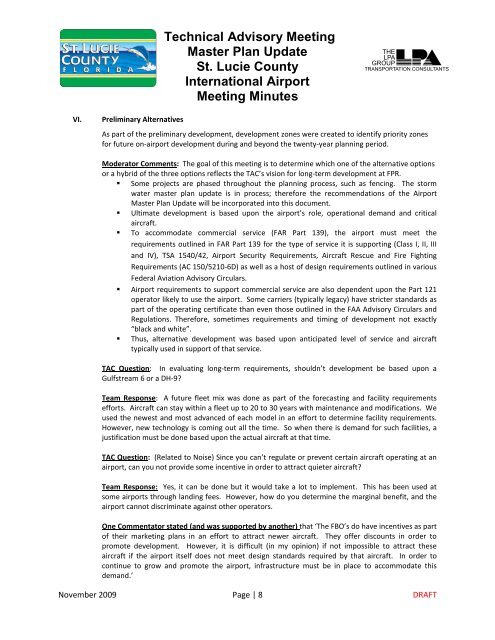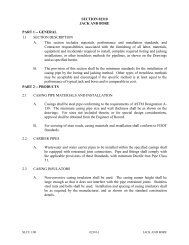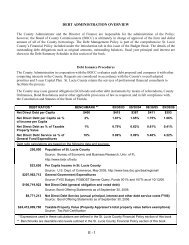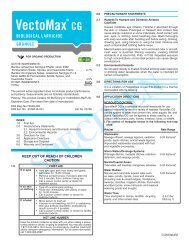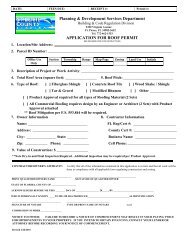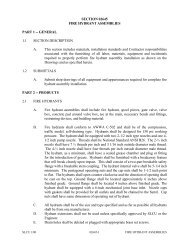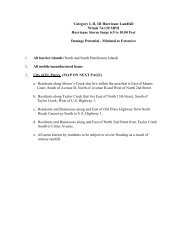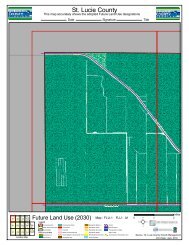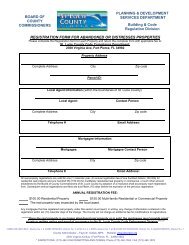TAC Meeting Minutes - St. Lucie County
TAC Meeting Minutes - St. Lucie County
TAC Meeting Minutes - St. Lucie County
You also want an ePaper? Increase the reach of your titles
YUMPU automatically turns print PDFs into web optimized ePapers that Google loves.
Technical Advisory <strong>Meeting</strong>Master Plan Update<strong>St</strong>. <strong>Lucie</strong> <strong>County</strong>International Airport<strong>Meeting</strong> <strong>Minutes</strong>THELPAGROUPTRANSPORTATION CONSULTANTSVI.Preliminary AlternativesAs part of the preliminary development, development zones were created to identify priority zonesfor future on-airport development during and beyond the twenty-year planning period.Moderator Comments: The goal of this meeting is to determine which one of the alternative optionsor a hybrid of the three options reflects the <strong>TAC</strong>’s vision for long-term development at FPR. Some projects are phased throughout the planning process, such as fencing. The stormwater master plan update is in process; therefore the recommendations of the AirportMaster Plan Update will be incorporated into this document. Ultimate development is based upon the airport’s role, operational demand and criticalaircraft. To accommodate commercial service (FAR Part 139), the airport must meet therequirements outlined in FAR Part 139 for the type of service it is supporting (Class I, II, IIIand IV), TSA 1540/42, Airport Security Requirements, Aircraft Rescue and Fire FightingRequirements (AC 150/5210-6D) as well as a host of design requirements outlined in variousFederal Aviation Advisory Circulars. Airport requirements to support commercial service are also dependent upon the Part 121operator likely to use the airport. Some carriers (typically legacy) have stricter standards aspart of the operating certificate than even those outlined in the FAA Advisory Circulars andRegulations. Therefore, sometimes requirements and timing of development not exactly“black and white”. Thus, alternative development was based upon anticipated level of service and aircrafttypically used in support of that service.<strong>TAC</strong> Question: In evaluating long-term requirements, shouldn’t development be based upon aGulfstream 6 or a DH-9?Team Response: A future fleet mix was done as part of the forecasting and facility requirementsefforts. Aircraft can stay within a fleet up to 20 to 30 years with maintenance and modifications. Weused the newest and most advanced of each model in an effort to determine facility requirements.However, new technology is coming out all the time. So when there is demand for such facilities, ajustification must be done based upon the actual aircraft at that time.<strong>TAC</strong> Question: (Related to Noise) Since you can’t regulate or prevent certain aircraft operating at anairport, can you not provide some incentive in order to attract quieter aircraft?Team Response: Yes, it can be done but it would take a lot to implement. This has been used atsome airports through landing fees. However, how do you determine the marginal benefit, and theairport cannot discriminate against other operators.One Commentator stated (and was supported by another) that ‘The FBO’s do have incentives as partof their marketing plans in an effort to attract newer aircraft. They offer discounts in order topromote development. However, it is difficult (in my opinion) if not impossible to attract theseaircraft if the airport itself does not meet design standards required by that aircraft. In order tocontinue to grow and promote the airport, infrastructure must be in place to accommodate thisdemand.’November 2009 Page | 8 DRAFT


